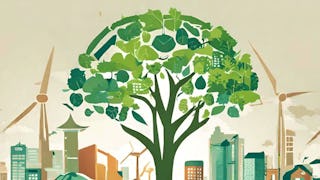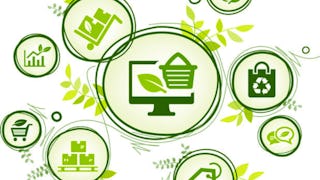Metals are present everywhere around us and are one of the major materials upon which our economies are built. Economic development is deeply coupled with the use of metals. During the 20th century, the variety of metal applications in society grew rapidly. In addition to mass applications such as steel in buildings and aluminium in planes, more and more different metals are in use for innovative technologies such as the use of the speciality metal indium in LCD screens.

Enjoy unlimited growth with a year of Coursera Plus for $199 (regularly $399). Save now.

A Circular Economy of Metals: Towards a Sustainable Societal Metabolism

Instructor: Ester van der Voet
8,289 already enrolled
(105 reviews)
What you'll learn
learn about the challenges related to metals production and usage
learn about the potential solutions that exist to act on these challenges
Skills you'll gain
Details to know

Add to your LinkedIn profile
See how employees at top companies are mastering in-demand skills

There are 7 modules in this course
Welcome to the course! This first module aims at introducing you to the main topic of the MOOC and to the teaching staff that you will be seeing throughout the whole course. Before you start with the first lessons we encourage you to have a look at our introductory materials and to introduce yourself in the forum in order to meet your classmates.
What's included
4 videos3 readings1 discussion prompt1 plugin
In Week 1, you will be introduced to the world of metals. What are they, what are their properties, what are they used for and how essential are they? We will address the difference between major and minor metals. Major metals are used in large basic applications such as buildings, cars, pipes, cables, bridges, trains and airplanes. Minor metals that are used mostly in all kinds of electronics and in new technologies, for example for wind and solar energy. The amounts used are much smaller. The minor metals have more attention in the news, because of problems with the supply from international trade, and are subject to criticality assessments. The major metals, on the other hand, are even more important, although less in the centre of attention. Without them, society would fall apart. In this course, we will focus mostly on those major metals. We also introduce the Sustainable Development Goals of the United Nations. These SDGs are agreed on by all nations that are part of the UN, and outline goals for the future of the global society. They include goals on economic development, social development, health and the environment and form a powerful framework to judge developments in resource use, including metal use.
What's included
7 videos2 readings1 assignment3 discussion prompts
In week 2, the metals challenge is outlined. Metals are indispensable for society, but they are also associated with environmental impacts, especially related to climate change. The challenge is defined as how can we provide society with sufficient metals, now and in the future, without compromising environmental quality? An important part of the challenge is caused by the rapidly rising demand for metals. Over the 20th century demand has risen steeply, and this is expected to continue over the next decades. In this week, we will teach the issues around metal supply, scarcity and criticality, and environmental impacts to sketch the magnitude of the metals challenge. We also will meet the apparent contradiction between some of the SDGs: we need metals to develop societies and build up the infrastructure, on the other hand, we also need to reduce environmental impacts that will only increase if we don’t do anything about it.
What's included
12 videos4 readings1 assignment3 discussion prompts
Week 3 and all subsequent weeks focus on solving the metals challenge. Obviously, we need to make changes in the metals system to reach a more sustainable situation and reconcile the different Sustainable Development Goals. When considering changes, it is important first to understand the system. We will be discussing stocks and flows of metals in society and see how they interact. In society, we do not just obey the laws of justice and economics, but also the laws of nature. It is important to realise that when contemplating solutions for the metals challenge. This week will be rather theoretical but will provide important information for the coming weeks.
What's included
5 videos3 readings1 assignment2 discussion prompts
Week 4 is rather packed with lectures on the different options to solve the metals challenge. You will meet experts from all over the world, who will lecture on materials and product design-for-environment and design-for-recycling, on the possibilities and also the barriers for remanufacturing, and on recycling as the last, but maybe most important resort to keep the metals in use. All these options aim at keeping up the stock-in-use of metals in society, while at the same time reducing the need to mine new metals. They all have their own strengths and limitations and can be regarded as pieces of the large puzzle aiming at solving the metals challenge, or in other words, reconciling the different SDGs.
What's included
11 videos3 readings1 assignment3 discussion prompts
In week 5, we try to get some idea of what the effectiveness could be of going for a circular economy. We do not consider all changes in society that have to be made to reach that, but simply have a look at whether or not, if we would reach a circular economy, we would indeed solve the metals challenge. Can we, theoretically, maintain supply and at the same time avoid supply problems and environmental issues in that way? And therefore, is it worthwhile pursuing a circular economy to reconcile the different SDGs? We use the case of aluminium to illustrate this.
What's included
6 videos4 readings1 assignment1 peer review1 discussion prompt1 plugin
In this final week of the course, we will look briefly into the future. What can we expect for the next decades or even the next century? We’ll introduce the concept of scenarios, storylines about the future that have no predictive value but have their value as imagination of what could happen, and what the consequences would be if it did. And we will apply that to our major metals. Will demand go on rising? What will happen with the environmental impacts? Does it help, from the point of view of metal production, to have a renewable energy system in the background? Will more circularity in our economy make a difference? In short, is it possible to reconcile the SDG development goals with the environmental ones?
What's included
6 videos2 readings2 assignments1 peer review1 discussion prompt
Instructor

Offered by
Explore more from Environmental Science and Sustainability
 Status: Preview
Status: PreviewLund University
 Status: Free Trial
Status: Free TrialUniversity of Colorado Boulder
 Status: Free Trial
Status: Free TrialUniversity of Colorado Boulder
 Status: Free Trial
Status: Free TrialUniversity of Colorado Boulder
Why people choose Coursera for their career




Learner reviews
105 reviews
- 5 stars
80.55%
- 4 stars
12.96%
- 3 stars
2.77%
- 2 stars
2.77%
- 1 star
0.92%
Showing 3 of 105
Reviewed on May 11, 2020
Great content, great professor. Worth the effort. Looking forward to learning more and be more engaged about the metals challenge and the circular economy
Reviewed on Nov 18, 2025
I feel like the course is a bit complex for beginner level - it could be simplified.
Reviewed on Mar 9, 2019
Loved the Dutch approach to design and sustainability!
Frequently asked questions
To access the course materials, assignments and to earn a Certificate, you will need to purchase the Certificate experience when you enroll in a course. You can try a Free Trial instead, or apply for Financial Aid. The course may offer 'Full Course, No Certificate' instead. This option lets you see all course materials, submit required assessments, and get a final grade. This also means that you will not be able to purchase a Certificate experience.
When you purchase a Certificate you get access to all course materials, including graded assignments. Upon completing the course, your electronic Certificate will be added to your Accomplishments page - from there, you can print your Certificate or add it to your LinkedIn profile.
Yes. In select learning programs, you can apply for financial aid or a scholarship if you can’t afford the enrollment fee. If fin aid or scholarship is available for your learning program selection, you’ll find a link to apply on the description page.
More questions
Financial aid available,
¹ Some assignments in this course are AI-graded. For these assignments, your data will be used in accordance with Coursera's Privacy Notice.





